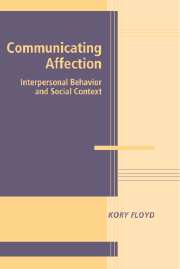Book contents
- Frontmatter
- Contents
- List of Tables
- List of Figures
- Foreword
- 1 AN INTRODUCTION TO AFFECTIONATE COMMUNICATION
- 2 THINKING ABOUT AFFECTION: THE THEORIES
- 3 ENCODING AFFECTIONATE MESSAGES
- 4 DECODING AND RESPONDING TO AFFECTIONATE EXPRESSIONS
- 5 BENEFITS OF EXPRESSING AND RECEIVING AFFECTION
- 6 RISKS ASSOCIATED WITH AFFECTIONATE COMMUNICATION
- 7 A NEW THEORETIC APPROACH
- 8 AFFECTIONATE COMMUNICATION IN HUMAN INTERACTION
- References
- Index
6 - RISKS ASSOCIATED WITH AFFECTIONATE COMMUNICATION
Published online by Cambridge University Press: 02 December 2009
- Frontmatter
- Contents
- List of Tables
- List of Figures
- Foreword
- 1 AN INTRODUCTION TO AFFECTIONATE COMMUNICATION
- 2 THINKING ABOUT AFFECTION: THE THEORIES
- 3 ENCODING AFFECTIONATE MESSAGES
- 4 DECODING AND RESPONDING TO AFFECTIONATE EXPRESSIONS
- 5 BENEFITS OF EXPRESSING AND RECEIVING AFFECTION
- 6 RISKS ASSOCIATED WITH AFFECTIONATE COMMUNICATION
- 7 A NEW THEORETIC APPROACH
- 8 AFFECTIONATE COMMUNICATION IN HUMAN INTERACTION
- References
- Index
Summary
The hardest of all is learning to be a well of affection, and not a fountain; to show them we love them not when we feel like it, but when they do.
– Nan FairbrotherPerhaps the aspect of affectionate communication that challenges human intuition more than any other is the fact that it sometimes produces negative outcomes. Intuition – and indeed, human social experience – suggest that affectionate behavior characterizes our most positive, intimate relationships; that it is a pleasing aspect of those relationships; and that it advances the welfare of those relationships and their participants. It is largely counterintuitive, therefore, to think of affectionate behavior as an instigator of distress, one that could even precipitate the demise of an otherwise positive relationship. Counterintuitive though it may be, there are very real risks and potential problems associated with the communication of affection, and an adequate understanding of affection exchange would elude researchers if they failed to acknowledge them.
Although the potential pitfalls of affectionate communication comprise one of its most intriguing aspects, they are also among the least studied aspects. I must begin by reiterating the caveat from the previous chapter that, although the reasons for expecting affectionate communication to be risky and problematic at times are more than adequate, the empirical research on this characteristic of affectionate behavior is very much in its infancy. In places, therefore, this chapter may seem to be longer on speculation than on actual evidence.
- Type
- Chapter
- Information
- Communicating AffectionInterpersonal Behavior and Social Context, pp. 121 - 139Publisher: Cambridge University PressPrint publication year: 2006



